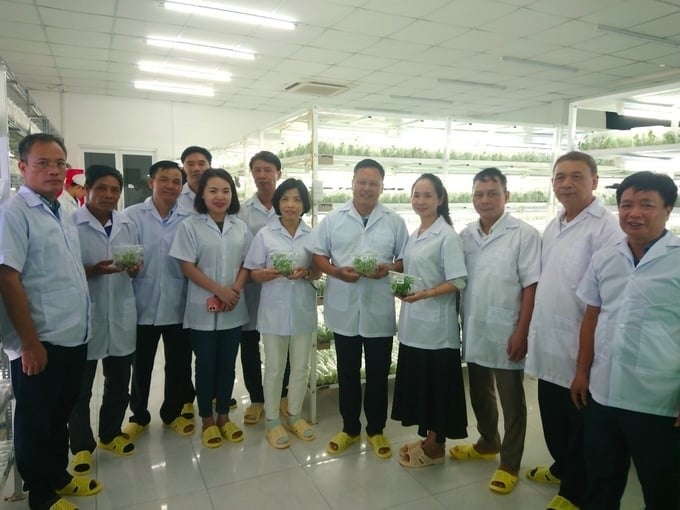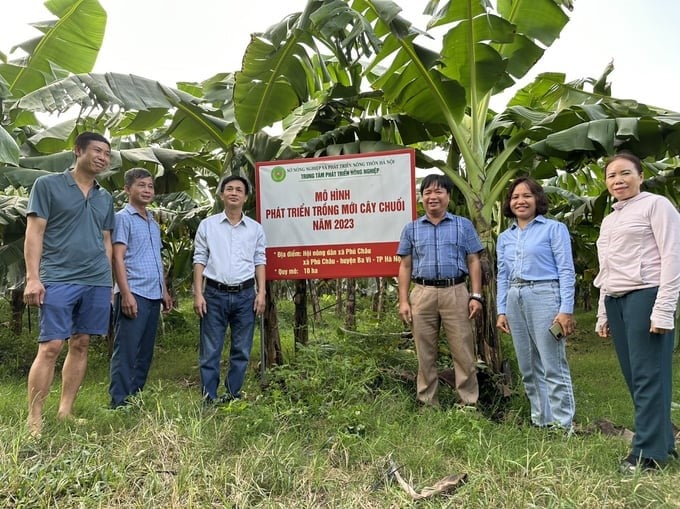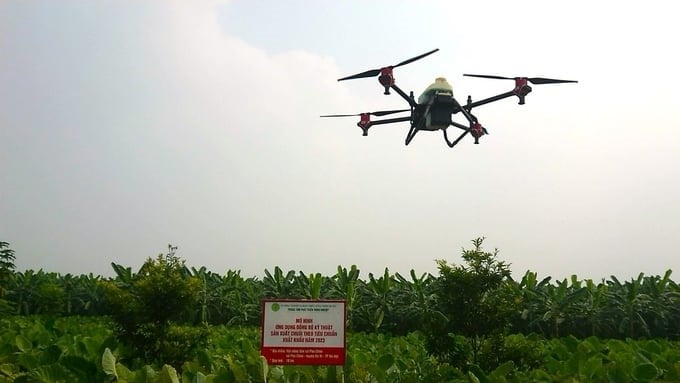May 29, 2025 | 07:55 GMT +7
May 29, 2025 | 07:55 GMT +7
Hotline: 0913.378.918
May 29, 2025 | 07:55 GMT +7
Hotline: 0913.378.918
Ms. Hoang Thi Hoa, Director of the Hanoi Agricultural Development Center, said that with a banana area of over 3,000 hectares, Hanoi Capital has a very methodical strategy for banana trees. "When building a plan for bananas, we conducted research in Hanoi’s banana areas and found that Panama disease is very common in Hanoi and many provinces and cities. This disease causes plants to die when they start to produce a bunch, making us very worried. In Thuan My commune, Ba Vi district, 100 hectares of bananas were completely wiped out by Panama disease.
We went to the Fruit and Vegetable Research Institute (FAVRI) to find a large banana enterprise in the South to study. Fortunately, we met Mr. Pham Quoc Liem, Chairman and General Director of Unifarm. He invited Hanoi farmers to visit the production area where seed, planting, care, and isolation in each plot of 5 hectares all follow the same standards as Philippine farmers are doing. Unifarm is also authorized by the world-famous banana company Dole to export goods to many countries.

The Hanoi delegation visits banana production technology in the South. Photo: TL.
After completing our studies, we invited Mr. Liem to go to the North to transfer technology and build a standard banana production area in Phu Chau commune, Ba Vi district. Unifarm will help growers consume products and bring products to supermarkets. Philippine experts also came here to survey. Currently, Unifarm is having to transport bananas from Binh Duong and has just built a raw material area in Ha Nam province. The company now adds Hanoi.
It is worth mentioning that the Cavendish banana variety grown in the North is sweeter and more delicious than in the South because of the large day-night temperature difference, which is very favored by Japanese partners. Therefore, Hanoi will create a growing area in Phu Chau for export to Japan, while other areas serve the domestic market. Fortunately, we now have a banana variety that is resistant to Panama disease, selected and created by FAVRI and produced by tissue culture technology," said Ms. Hoang Thi Hoa.
To implement the plan to produce bananas according to export standards in 2023, the Hanoi Agricultural Development Center coordinated with FAVRI to organize a training class for 10 cooperative officials and typical farmers in Ba Vi and Me Linh districts. They learn about theories such as planning, garden design, care, high-tech applications, and building chain linkages to practices on growing, covering butches, pruning buds, fertilizing, and investigating, detecting, preventing, and controlling pests. The unit also coordinated with communes and cooperatives to organize five training classes for 150 farmers and organized a delegation to learn about experiences in Binh Duong and Long An provinces.

Banana-growing model in Phu Chau commune, Ba Vi district. Photo: TL.
The Center also supported 50% of seeds, fertilizers, pesticides, butch covering bags, and spraying labor and appointed technical staff to monitor and direct production. In the first phase in April 2023, 20 hectares with 21,000 Artocarpus interger banana tissue culture seedlings were grown in Van Khe, Phu Chau, and Hoang Kim sites. The second phase, in September 2023, planted 20 hectares with 21,000 plants. As a result, the survival rate reached 98%, and the plants grew well with concentrated pest control using drones. The yield is expected at 45–46 tons/ha, with a revenue of VND 300–350 million/ha and an economic efficiency of VND 150–170 million/ha.
At the same time, build a model applying synchronous banana production techniques according to export standards on an area of 10 hectares in Phu Chau commune, Ba Vi district. There are the applications of banana bunch covering, pest control at the right time with drones, a water-saving irrigation system, and VietGAP production. Thanks to that, labor costs are reduced by 30–40%, and the average yield is expected to be 47 tons/ha. Because it is harvested during the Tet holiday, the selling price is high, reaching VND 330–340 million/ha, and the economic efficiency is VND 160–170 million/ha. VietGAP-certified products meet standards for export.

Spraying pesticides on bananas with drones. Photo: TL.
The Center also coordinated with the joint venture between NATEK Science and Technology JSC and NHONHO Technology Co., Ltd. to issue certificates of banana production according to VietGAP standards for sites participating in the model with 100% support. During the implementation process, NHONHO Technology Co., Ltd. organized sampling of soil, water, and product samples to analyze and evaluate the quality of soil, water, and products in the production area. As a result, the indicators of heavy metal content in the soil are all within the allowable threshold, and the products do not contain pesticide residues.
NATEK Science and Technology JSC conducted surveys and evaluated shortages; provided instructions for making warehouses to preserve fertilizers, pesticides, labor protection equipment, medicine cabinets, and warning signs. Guide farmers to record production logs for traceability from the stages of growing and care to harvest and product preservation, etc. Issue three VietGAP banana production certificates for 100% of the production area in 2023 in Phu Chau commune, Ba Vi district, and Hoang Kim and Van Khe communes, Me Linh district.
The Center also coordinated with contractors to install water-saving irrigation systems for 37 hectares of developing new banana plantations in cooperatives and communes. Thereby, helping to minimize irrigation labor costs and meet water needs according to the growth and development stages of the plant.
With the goal of sustainable development, the Center has strengthened trade and consumption promotion, including supporting production households with carton boxes to package products, traceability stamps, production area signs, and installing the hanoi.egap.vn software. Especially, support refrigeration equipment to serve banana preservation at households in Phu Chau commune, Ba Vi district, with a capacity of 3,000–3,500 kg of bananas/preservation period. The high-tech application in preservation helps to improve design and quality and reduce post-harvest losses by 15-20% compared to no preservation.
In addition, the unit also linked consumption with two enterprises, namely Unifarm Company and Lam Thieu Import-Export Co., Ltd., with an average output of 5 tons/month. Lam Thieu Company alone purchases bananas in the entire Me Linh district area that has been granted a growing area code, with an output of 6–8 tons/month sold mainly to the Chinese market via official export.
Translated by Huyen Vu Thu
/2025/05/25/4127-3-073637_820.jpg)
(VAN) Thanks to the promotion from an FAO-implemented project, vegetable production in greenhouses in Moc Chau has seen strong development, from 1.5 hectares in 2021 to nearly 50 hectares in 2024.

(VAN) FAO has recently supported USD 140,000 to implement the project 'Risk mitigation human-animal interface risks through disease control initiatives in pig farming.'

(VAN) The People's Committee of Tra Vinh province has approved an adjustment to the investment policy for the Green Hydrogen Plant project, increasing its area to approximately 52.76 hectares.
![Reducing emissions from rice fields: [2] Farmers’ commitment to the soil](https://t.ex-cdn.com/nongnghiepmoitruong.vn/608w/files/news/2025/05/05/dsc08881jpg-nongnghiep-140632.jpg)
(VAN) Clean rice cultivation model in Thuong Tan commune, Bac Tan Uyen district, is assisting local residents in achieving sustainable agriculture by substantially reducing costs, increasing productivity, and protecting the environment.

(VAN) At the conference to disseminate Resolution No. 68, AgriS introduced its digital agricultural ecosystem and reaffirmed its commitment to accompanying the Government in promoting private sector development and sustainable agriculture.

(VAN) 'Blue Ocean - Blue Foods' initiative is designed to restore marine ecosystems and establish sustainable livelihoods for local communities by cultivating a minimum of 1,000 hectares of cottonii seaweed in the first three years.
/2025/05/21/4642-3-112707_603.jpg)
(VAN) The V-SCOPE project has made direct contributions to three out of six pillars of the Comprehensive Strategic Partnership between Vietnam and Australia.